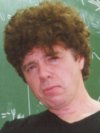Applied mathematician joins the NRF's A team
21 October 2002
According to the NRF's evaluation standards, A–rated scientists are researchers who are accepted by their peers as world leaders in terms of the high quality and impact of their recent research outputs.
Barashenkov hails from Dubna, 120 km north-west of Moscow, a scientific village built around the Joint Institute for Nuclear Research. He studied at the Moscow University in the Department of Physics and his PhD was on particle-like solutions to lower-dimensional field theories. It was only when he returned to Dubna that he developed a taste for maths.
What brought him to South Africa? “Things in Russia deteriorated rapidly around 1989–90. By 1991 research funding had become so scarce that few could afford it. In 1992 I had two offers, one from UCT and another from Montreal. In 1992 Russians were not as materialistic as they are nowadays, so I chose life 'at the frontier'. There were other reasons; my French was even worse than my English and I was also fed up with ice and snow. In 1992 I landed in Cape Town and although things were slightly different, I never regretted it.â€
He recalls his job interview with a smile: “In 1991 the USSR and South Africa did not have formal relations. Consequently, George Ellis interviewed me in the bar of the International Centre for Theoretical Physics in Trieste. My main aim was to pretend I could speak English and to avoid discussing teaching (I had never presented a lecture). I tried to say as little as possible. Of course, I knew who I was speaking to: I had George's book on my bookshelf, so it was easy to get him talking. Consequently, he made a favourable opinion about my linguistic and teaching skills and I had a letter of offer as soon as I went back home.â€
Barashenkov works on various aspects of theory of solitary waves, or solitons. This is a unique area in the sense that it belongs both to the pure and applied mathematics. “Solitons are localised bunches of energy which propagate with their shapes and speeds unchanged. These objects have been known for some time (think of tsunamis), but it was only at the end of the twentieth century that soliton-bearing systems were discovered to have a beautiful and powerful underlying symmetry,†he explains.
“It turned out that there were several (not many, unfortunately) nonlinear partial differential equations that can be solved with the same degree of generality as if they were linear. The method of solution is known as the Inverse Scattering Transform and it is regarded by many as the most important discovery in mathematical physics of the twentieth century.â€
According to the mathematician, the discovery has revolutionised and given strong impetus to a whole series of areas of mathematics and physics, from algebraic geometry to the string theory in elementary particles. “Entire new branches of mathematics have emerged as a result of this discovery, for example, quantum groups,†he notes.
While Barashenkov says the research may sound like “ivory tower stuffâ€, there is an important applied component to it. “Due to their stability and robustness, solitons are ideal carriers of energy and information. A particularly fresh example is provided by their use in non-linear optics. The backbone infrastructure of today's information and communication technology is fibre-optic telecommunications networks. In these networks, billions of light pulses per second carry information down fibre circuits for telephones, computers and cable TV.
“The silent revolution in high-speed optical transmission began several years ago when Alcatel in France, and then Marconi Communications in the UK, started using new systems capable of transmission speeds in excess of 1 000 Gbit/s over thousands of kilometres, eliminating the need for high-cost regeneration of optical signals. These revolutionary systems exploit exactly the solitons, the bell-shaped, self-regulating pulses.†Although it would be unrealistic to expect the country to become a global competitor in telecommunications any time soon, the research is important to South Africa.
Barashenkov believes that due to SA's strategic position on the continent, the country can't afford not to keep abreast of developments in soliton communications. “We should have expertise, if not in producing, then at least in maintaining and supporting, long-distance fibre-optic networks. There should be somebody at least to assess proposed telecommunications projects for Africa, someone who could be consulted on these strategic issues.â€
Though modest about the A–rating (“Please don't put me on the front page or I'll have to be on time for lectures'†he quips), he is passionate about research and describes himself as fortunate to work in a faculty where the dean is “a frantic researcher himselfâ€. “I am strongly convinced that teaching without research is dead. What can be exciting about a course that is presented simply by re-telling the textbook? It's like shooting from a gun without a target, just for the sake of the sound.â€
Barashenkov is UCT's first new A–rated researcher for some time. “I think this is due to the fact that we have strong competition. But I am happy to see that there is a growing understanding of the importance of research as a driving force for the entire academic life at UCT.â€
 This work is licensed under a Creative Commons Attribution-NoDerivatives 4.0 International License.
This work is licensed under a Creative Commons Attribution-NoDerivatives 4.0 International License.
Please view the republishing articles page for more information.
Related
Alderman Owen Kinahan (1955–2026)
06 Jan 2026
Celebrating UCT’s outstanding Thuthuka results
29 Dec 2025
Looted African belongings must be returned
29 Dec 2025
Republished










